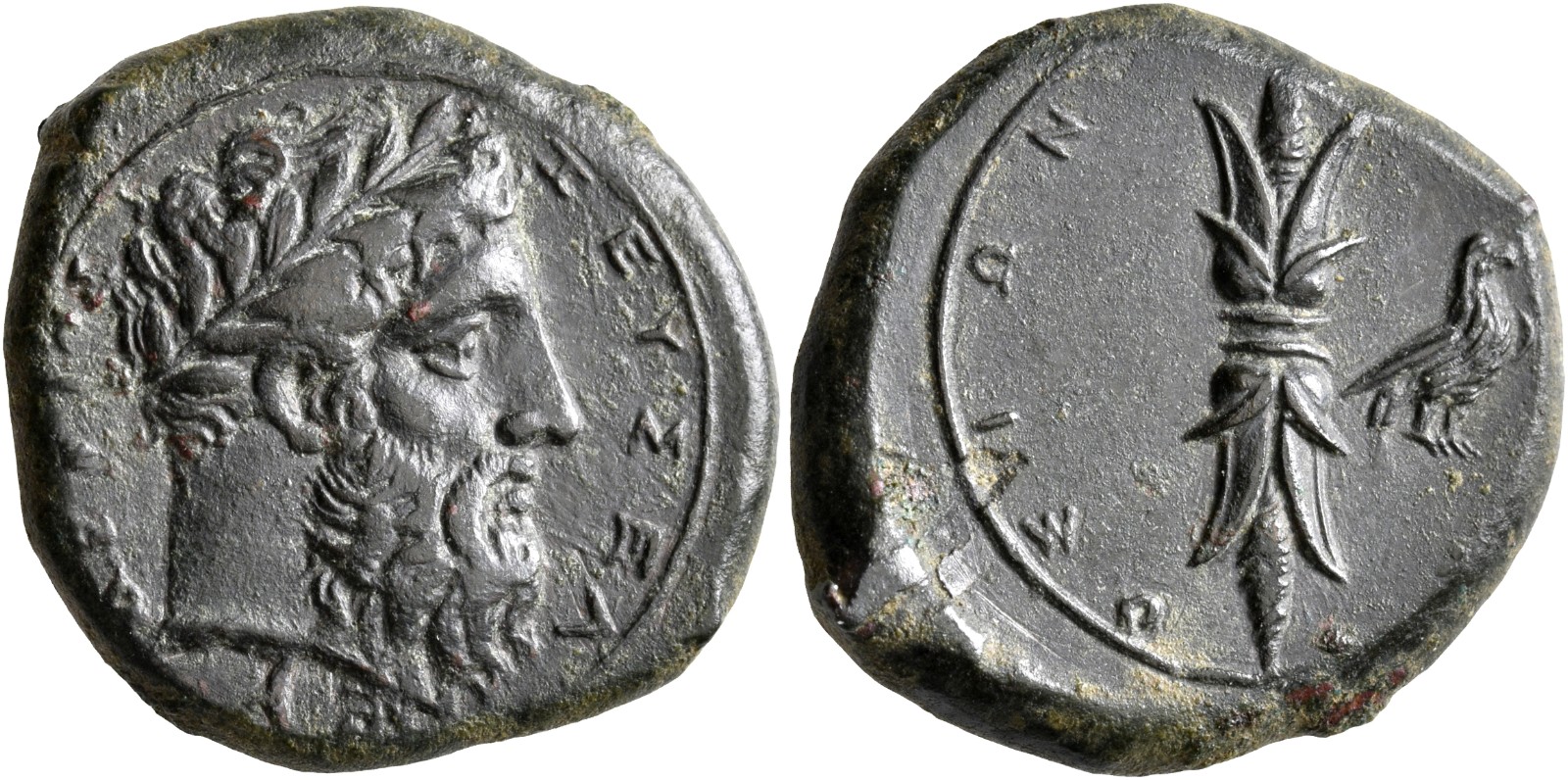S 1542 - Syracuse (Campanian mercenaries), bronze, tetrantes (344-338 BCE)
From SILVER
344 BCE - 338 BCE Bronze
Description
| ObverseInscription or printing placed on the obverse.: | ZEYΣ EΛEYΘEPIOΣ (Greek).Laureate head of Zeus to right |
| ReverseInscription or printing placed on the reverse.: | ΣYPAKOΣIΩN (Greek).Thunderbolt, to right, eagle standing right |
Mint and issuing power
| MintIdentifies the place of manufacture or issue of a numismatic object.: | Syracuse | Ancient regionAncient region.: | Sicily | Modern countryModern country: Italy | AuthorityIdentifies the issuing power. The authority can be "pretended" when the name or the portrait of X is on the coin but he/she was not the issuing power. It can also be "uncertain" when there is no mention of X on the coin but he/she was the issuing power according to the historical sources: | Campanian mercenaries |
Chronology
| FromIdentifies the initial date in a range assigned in a numismatic context. | 344 BCE | toIdentifies the final date in a range assigned in a numismatic context.. | 338 BCE | PeriodTime period of the numismatic object.: Classical 480-323 BC |
Physical description
| MetalThe physical material (usually metal) from which an object is made.: | Bronze |
Median weightMedian of the weights of numismatic objects (in grams). in grams | 13 | DenominationTerm indicating the value of a numismatic object. Examples: tetradrachm, chalkous, denarius.: | tetras | StandardStandard.: |
Image

S 1542 - Syracuse (Campanian mercenaries), bronze, tetrantes (344-338 BCE).jpg [1]
References
| Die study referencePublication of the study: | Castrizio 20001Castrizio 2000, p. 110-113 | ||
| Coin series referenceReference to coin series study: | HGC 22HGC 2, n° 1440 | ||
Obverse dies distribution
| FrequencyFrequency of specimen in distribution. ᵖ | Number of obversesNumber of obverse dies. ᵖ (o) | % (o) | Number of coinsNumber of coins. (n) | % (n) | Die nameName(s) of the die(s). |
| 1 | 10 | 27.03 | 10 | 10.1 | 3, 4, 7, 10, 12, 15, 16, 22, 33, 35 |
| 2 | 12 | 32.43 | 24 | 24.24 | 11, 18, 19, 20, 25, 26, 27, 28, 31, 32, 36, 37 |
| 3 | 6 | 16.22 | 18 | 18.18 | 1, 2, 13, 14, 23, 24 |
| 4 | 5 | 13.51 | 20 | 20.2 | 5, 6, 9, 17, 30 |
| 5 | 2 | 5.41 | 10 | 10.1 | 8, 34 |
| 7 | 1 | 2.7 | 7 | 7.07 | 21 |
| 10 | 1 | 2.7 | 10 | 10.1 | 29 |
| Total | 37 of 37 | 100 | 99 of 99 | 99.99 |
Reverse dies distribution
no distribution is available
Quantification
| Number of obversesNumber of obverse dies. ᵖ (o) | 37 | Number of singletons (o1)The number of singleton coins. ᵖ | 10 |
| Number of reverse diesNumber of reverse dies. (r) | 65 | Number of coinsNumber of coins. (n) | 99 |
| Coins per obverse dieNumber of coins per obverse die. (n/o) | 2.68 | Coins per reverse dieNumber of coins per reverse die. (n/r) | 1.52 |
| Reverse per obverse ratioRatio of obverse dies divided by reverse dies. (r/o) | 1.76 | Percentage of singletons (o1)number of coins (n) divided by the number of singletons (o1) ᵖ | 27.03 % |
| Original number of dies (O) (Carter 1983 formula)The estimation of the number of coins according to Carter 1983 ᵖ | 49.71 | Coins struck if 20,000 as average productivity per dieCoins made if the average productivity for obverses (according to Carter) is 20,000. ᵖ | 994,200 |
| Original number of dies (O) (Esty 2011 formula)The estimation of the number of coins according to the singleton formula in Esty 2011 ᵖ (O) | 59.08 | Survival rate if 20,000 as average productivity per dieSurvival rate if average productivity is 20,000. ᵖ | 0.00010 |
| Coverage (o = % of O) (Esty 1984 formula)Esty 1984 - coverage (% of O) ᵖ (o = % of O) | 89.9% | Die productivity if survival rate 1/2,000Average productivity if survival rate is 1/2,000. ᵖ | 3,983.1 |
| Weight of silver (in kg) if 20,000 coins per die (O = Carter formula)Carter 1983 * Median weight * 20000 (*10 if gold or electrum) ᵖ | n.a. | Die productivity if survival rate 1/5,000Average productivity if survival rate is 1/5,000. ᵖ | 9,957.75 |
Remarks
References
- ^ Castrizio, Daniele (2000), La monetazione mercenariale in Sicilia. Strategie economiche e territoriali tra Dionisio I e Timoleonte, Catanzaro, Soveria Mannelli, 126 p. and 18 pl.
- ^ Hoover, Oliver D. (2012), The Handbook of Greek Coinage Series. 2. Handbook of the Coins of Sicily (Including Lipara). Civic, Royal, Siculo-Punic, and Romano-Sicilian Issues. Sixth to First Centuries BC, Lancaster-London, 489 p.